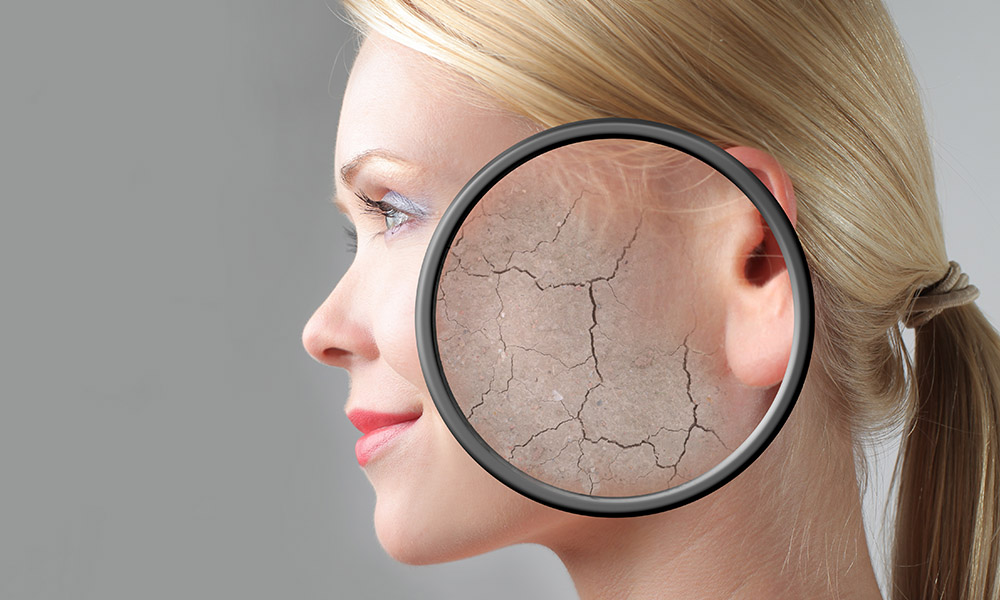Skin is resilient. Not only does it help protect the body from environmental threats, but it helps retain moisture. Stress, sun, and various lifestyle factors can damage the moisture barrier, causing the skin to become dry and dull. For some, dryness is a temporary issue that can be resolved by repairing the skin’s moisture barrier. In other cases, it is a skin type that may require more long-term management.
As a skincare professional, it’s your job to assess your client’s skin type and to identify skin concerns. For clients with dry skin, you’ll need to know the difference between dry and dehydrated skin, and you should understand the unique causes of both to determine the ideal treatment.
Here’s what you need to know about treating a client with dry skin…
Recognizing Dry vs. Dehydrated Skin
When your client first enters the treatment room, the first step is the initial consultation and skin analysis. In performing the skin analysis, you’ll assess the current condition of the skin and ask your client about their skin concerns. At first glance, you should be able to identify key issues like dryness, sensitivity, or breakouts. An in-depth analysis will give you more information about the strength of the skin’s moisture barrier which will give you additional clues about whether the skin is dry or dehydrated.
First and foremost, remember dryness refers to a skin type while dehydration refers to a skin condition. Dry skin may be flaky or itchy, but dehydrated skin often appears tight or dull with exaggerated wrinkles.
Dry skin is a skin type which produces less sebum than normal, so the skin has trouble retaining moisture. This can lead to itching, flaking, and general discomfort. Dehydrated skin, on the other hand, doesn’t have enough water. It can be caused by a combination of environmental and lifestyle factors. To compensate for lack of moisture, dehydrated skin may over-produce oil. This is why it’s important to perform a deeper analysis of both the appearance and feel of the skin.
What Causes Dry Skin?

As a skincare professional, you are a trusted resource to your clients. In addition to analyzing the skin and identifying concerns, it’s your job to communicate and educate. Based on the results of the skin analysis, you’ll need to explain to your client whether they have dry or dehydrated skin.
Dry skin is a skin type – it is something you are born with. It means the skin doesn’t produce enough oil, so the natural moisture barrier may not be strong enough to protect against external aggressors. Dehydrated skin is typically caused by external factors and may be the result of a compromised moisture barrier resulting in chronic dry skin.
Here are some of the factors that may exacerbate dry skin:
- Cold weather or dry air
- Bathing in water that is too hot
- Harsh soaps, detergents, and skin products
- Concurrent skin conditions (like psoriasis or atopic dermatitis)
- Not drinking enough water
- Underlying health issues (like diabetes or hypothyroidism)
- Use of certain medications
- Excessive exposure to UV light
- Aging (fluid retention and oil production decrease with age)
One of the more difficult aspects of your job is helping the client understand their skin. Every client wants to experience immediate results, but the truth is it takes time to resolve most skin conditions. In addition to performing the treatment yourself, you’ll need to make sure your client understands how to continue treatment at home to obtain the desired results.
The Basics of Treating Dry Skin
Once you’ve identified your client’s skin type and skin concerns, the next step is treatment. When dealing with dry skin, the ultimate goal is to add nourishing, natural oils, restore hydration and rebuild the skin’s moisture barrier. During treatment, it’s important to avoid stripping what natural oil the skin has. Clients with sensitive or acne-prone skin may need to be treated more delicately.
Here are some recommendations for treating dry skin:
- Start with a gentle, non-foaming cleanser. Cleansers that contain detergents and foaming agents can strip away natural oils and damage the skin’s moisture barrier.
- Use an exfoliant that contains moisturizing agents like shea butter, coconut oil, or ceramide. It is important to remove accumulated dead cells from the skin’s surface which might diminish the absorption of nourishing serums and
- Massage the skin to help soften the pores, boost circulation, and stimulate oil production – you may want to avoid using the steamer on dry skin because overuse can lead to dehydration.
- Apply a hydrating serum with hyaluronic acid to improve the skin’s ability to absorb and retain moisture. Serums should be applied before moisturizer to maximize absorption.
- Choose a thicker nighttime moisturizer. Make sure to choose an oil-free, non-comedogenic moisturizer to boost overnight hydration.
- Always apply sunscreen for UV protection during the day, even in the winter. Just make sure you don’t apply it in combination with products that increase photosensitivity.
Dry skin tends to absorb product quickly, but it may take time for the moisture barrier to regain its strength. Advise your client to follow a daily routine of cleansing and moisturizing, providing recommendations for products appropriate for their individual concerns and skin conditions.
Tips for Recommending Products

The most important steps in treating dry skin is restoring oils and upholding moisture. When it comes to hydrating dry skin, however, your client may assume any moisturizer will do. It is your job as a skincare professional to help your client understand their skin type and their skin’s individual needs – this includes making appropriate product recommendations for at-home skincare.
Here are some of the best ingredients to recommend for dry skin:
- Lactic Acid – Typically used as gentle exfoliant, lactic acid is a natural moisturizing factor that also helps keep the skin balanced which boosts its ability to absorb hydrating products. In addition to exfoliating and hydrating, lactic acid may have brightening benefits as well.
- Hyaluronic Acid – This acid is known for its ability to hold 1,000 times its weight in water. Hyaluronic acid is an extremely hydrating ingredient, just make sure to check the size of the molecules which determine how deeply the acid penetrates into the skin.
- Ceramides – These are naturally occurring lipids which are a key building block of the skin’s moisture barrier. Ceramides hold the skin cells together, keeping in hydration. As you get older, the skin produces fewer ceramides which means topical supplementation may be necessary.
- Natural Oils – While hyaluronic and lactic acids help deliver moisture to the skin, ceramides and natural oils help keep it in. Dry skin doesn’t produce enough oil, so you may need to supplement with natural oils like avocado, jojoba, and olive oil.
Your clients trust you to help them achieve their skin goals. That being said, it’s part of your job to set realistic expectations and to help your clients understand their skin so can take a more active role in caring for it. Follow the tips above to treat and recommend products for clients with dry skin.

